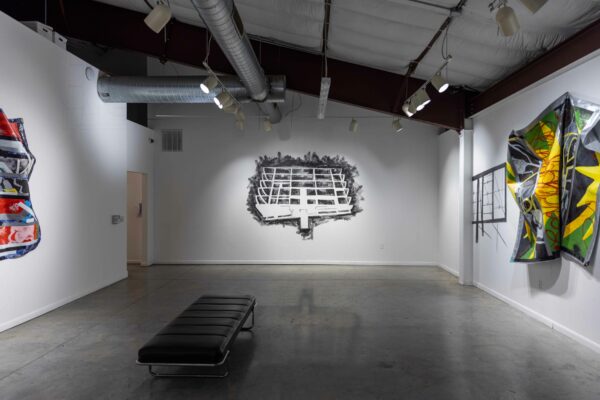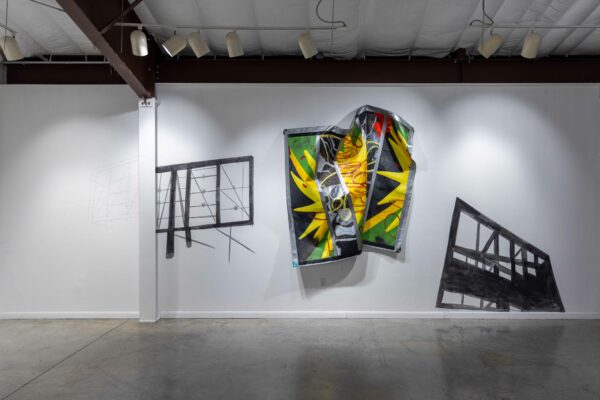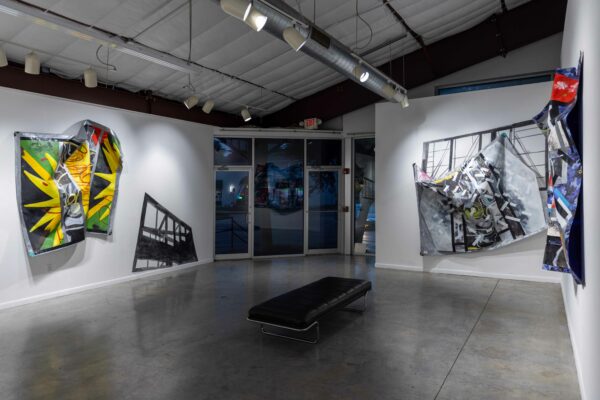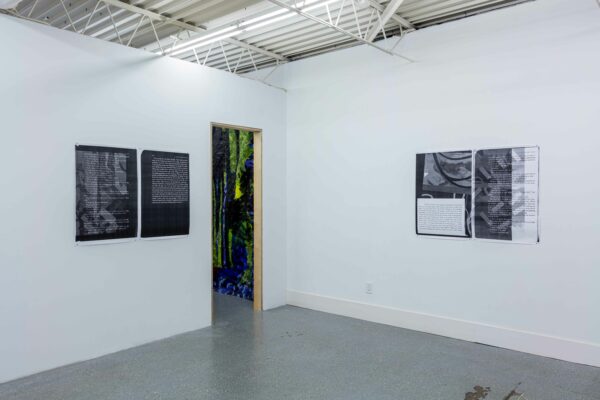Aren’t billboards just museums for the poor? What is the difference between a royal portrait taking pride of place in a well-lit and air-conditioned gallery and a photo of a smiling medical practitioner, this country’s closest thing to a courtier, guiding clients towards a hospital? The double exhibition of Carris Adams, at Art League Houston and Basket Books & Art, inspires these questions thanks to the artist’s use of recycled billboard vinyl. Hers is the language of poverty, meaning vulnerability to urban commercial onslaught, cheapness of materials, and the overall style of patch and mend. But it’s not just recycling for recycling’s sake. Adams translates the external to the internal and connects the lurid visuals of advertising and signage to existential questions of education of self and the community.

Carris Adams, “Untitled,” 2023, graphite on wall (site-specific wall drawing), installation view, 252 x 120 inches
Adams’ show at Art League Houston consists of paintings from her grad school years (2013-2017), which were cut, rearranged and glued to a recycled billboard. Energetic intrusions of duct tape mark the “division of time,” as the artist says, and also serve as brushstrokes. These tangible objects exist in a space that is rhythmically structured with wall drawings of billboard constructions. Empty black husks are punctured with silver spray-painted dots that look quite mysterious until the artist explains them simply as “fixtures for bulbs,” noting that their inclusion was needed to “change the pace and speed in which you view the work.”
Through canny foreshortening tricks, Adams makes the constructions feel as if they hover above the viewer. The vinyl and canvas paintings look crumpled, floating, ripped from the illusory contraptions. Here, the artist employs a clever inversion. The billboard constructions are usually solid and unchanging, but here they are ephemeral and will disappear after the show is over. The ads are quick to rotate in real life, but their physicality in the exhibition is much more pronounced. We are allowed a peek into many different fragments and textures, an ornament here, a piece of a letter there, pulled together by force of duct tape. Energetic lines of black, blue, and white direct our gaze through the works’ surface, sometimes resembling a fire exit scheme in their immediacy.
At Basket, Adams shows a wall-sized recycled vinyl piece with the phrase “AND YOU THE GUMP” written on it in gigantic black letters, along with several prints that utilize a passage from A Lesson Before Dying, an award-winning 1993 novel by Ernest Gaines. Set in Louisiana in the late 1940s, the book tells the story of death row inmate Jefferson, whose family persuades university-educated Grant to teach him school fundamentals before he’s executed. Adams picks a scene from later in the book, when the fictional town’s priest admonishes the teacher for his lack of faith and tries to fight for the soul of a dead man walking. Their conversation is set against stark black and white abstraction. Having no embodied knowledge of the Black experience, I wouldn’t confidently place this literary passage in the context of North American history. However, the verbal duel between the holy man and the intellectual looks familiar, very close to the concerns of 19th century Russian literature with its debates about the relative merits of enlightenment, reason, and spirituality as means to elevate the human condition of former serfs. Of course, then the October Revolution came and sold itself fraudulently to the wretched of the earth as the final emancipation beyond all religion.
In an oblique way, the scene corresponds to Adams’ own trajectory in art making. In a lucid and hilarious essay for Abstractions magazine, she sketches out her Bildungsroman: starting out as a figurative painter in the style of Kerry James Marshall and Carrie Mae Weems, she slowly familiarized herself with Black abstraction and soon realizes that everything is abstract, up to and including language. “From pidgin English, to shorthand, to acronyms, to dialect — letters can be the subject, the shape, and the medium,” Adams writes, noticing the “slippages” between the wording and the meaning in low-price commercial signage. While the vocabulary of figurative painting — or, as Adams calls it, “the song and dance of our tragic histories, precarious present and unknown future” — starts and ends with a European, Christian, dramatic catalog of ecstasies, miseries, and triumphs, abstraction is closer to “reading, writing, and ‘rithmetic’” that the priest in the Gaines’ novel deems “not enough,” calling the teacher “the gump.”
But just as you can figure out quite a few things about where you are and what is to be done using the basic skills of middle school curriculum, abstraction goes a long way, too. Maybe the closest thing to what Adams does are Al Loving’s 1970s pieces, made from his own paintings, cut up and stitched back together under the influence of nineteenth-century quilts, those beautiful creations of need and economy of means. Just as Loving made use of the poverty language of the early industrial age, Adams sorts through the post-industrial debris with similar vigor and ingenuity.
Carris Adams: A Lesson is on view at Basket Books & Art through January 28. Carris Adams: And so it goes… is on view at Art League Houston through February 10.







